
IBM says the cognitive era is one in which companies compete with each other by using algorithms, which are to a great deal responsible for how those companies develop, advance and succeed. Cognitive computing capabilities are emerging that resemble human learning and thinking processes: Discovery, Decision and Engagement. It’s taking data analysis as we know it to an entirely new level.
As we heard in many of the presentations at IBM BusinessConnect Helsinki 2016, digitalisation is a data-driven enabler for re-inventing and re-imagining the customer experience. That new experience can then be implemented through fresh business models and ecosystem-based collaboration. Partnerships are everything, because partners make innovation easier to achieve.
IBM BusinessConnect 2016 brought together a big crowd of about 1,500 enthusiastic professionals looking to get inspired and excited about the partnership opportunities offered by digitalisation and the Internet of Things (IoT). The program was fully packed with interesting presentations from IBM, KONE, Finnair, cyborg Neil Harbisson, and Comptel’s hybrid cloud, just to mention few. Here’s a summary.
The IBM/Comptel Telco Story
IBM and Comptel have a long-standing partnership that stretches over 10 years. Comptel is both a partner and a customer of IBM software and services. Together, we are actively helping telco operators around the world transform their OSS/BSS environments. Our strategic partnership is in the area of Digital Service Lifecycle Management (DSLM) with the IBM Architecture for Cloud-Based Networking, devising a new model for service orchestration and delivery of SDN/NFV.
Internally, Comptel deploys IBM cloud software assets in a hybrid environment for R&D, testing, training and more, both on-premises in Comptel’s own data centre and off-premises in the cloud. This hybrid workstyle offers us flexibility and agility, creating a better customer experience, whether we are using services on- or off-premises in single or multi-tenant mode.
IBM, like Comptel, believes in this hybrid cloud model. A presentation from IBM explained the global movement toward cloud, but stressed that cloud should not be viewed simply as a blanket destination: “Not every service needs to move to the cloud,” said the presenters. The key consideration for telcos is to figure out which services are better to run in a cloud environment, and then achieve seamless end-to-end orchestration across the hybrid network environment. Ultimately what matters most is being able to deliver a compelling customer and user experience irrespective of where the service resides.
Cognitive Computing in Healthcare
IBM and Tekes discussed their partnership, which resulted in the creation of the Watson Health Center of Excellence in Finland. Their aim is to improve the health of citizens, further local innovation and strengthen the Finnish healthcare business ecosystem. The partnership invites health companies to build an ecosystem on top of IBM’s Watson platform to create “the world’s most advanced data-led IoT hospitals.” Healthcare touches us all, and there’s a big need and sense of urgency around creating new innovative and disruptive health services. The ultimate vision is to establish a hospital-free model where the hospital is a base for service and care at home.
Moving People at an Urban Scale
 KONE, a Finland based company serving more than 400,000 customers worldwide, moves more than 1 billion people every day with more than 1 million elevators and escalators. They anticipate the urbanisation trend to accelerate business, as more than 200,000 people are moving into cities every day, driving the need for sustainability and smart urban living. By embracing open innovation, KONE benefits from fresh ideas from outside their own company. Through IBM Watson, KONE has made a massive volume of escalator and elevator data available to third-party startup companies to innovate. This ecosystem and collaborative approach to innovation will be essential for KONE to take its business to the next level.
KONE, a Finland based company serving more than 400,000 customers worldwide, moves more than 1 billion people every day with more than 1 million elevators and escalators. They anticipate the urbanisation trend to accelerate business, as more than 200,000 people are moving into cities every day, driving the need for sustainability and smart urban living. By embracing open innovation, KONE benefits from fresh ideas from outside their own company. Through IBM Watson, KONE has made a massive volume of escalator and elevator data available to third-party startup companies to innovate. This ecosystem and collaborative approach to innovation will be essential for KONE to take its business to the next level.
San Fran to Finland, Nonstop
 The airline industry is also undergoing a digital transformation. Digitalisation is changing how airline employees work, how operations are run and how customers are served. Finnair is at the leading edge. Through an innovative strategic collaboration with Slush, Finnair has arranged exclusive direct flights to Europe’s leading startup event for attendees traveling from San Francisco. The San Francisco-to-Helsinki flight path will part of Finnair’s ongoing flight options starting in June 2017. It’s one example of how Finnair is working with leading startups to create better customer experiences and possibilities.
The airline industry is also undergoing a digital transformation. Digitalisation is changing how airline employees work, how operations are run and how customers are served. Finnair is at the leading edge. Through an innovative strategic collaboration with Slush, Finnair has arranged exclusive direct flights to Europe’s leading startup event for attendees traveling from San Francisco. The San Francisco-to-Helsinki flight path will part of Finnair’s ongoing flight options starting in June 2017. It’s one example of how Finnair is working with leading startups to create better customer experiences and possibilities.
A Union Between Biology and Technology
 Could you imagine hearing colours?
Could you imagine hearing colours?
The most exciting and memorable speech at IBM BusinessConnect was given by cyborg Neil Harbisson. He was born with an extreme form of colour-blindness that meant he could only see grayscale. But, with the help of an internet-connected head implant that converts light into sound, Harbisson is now able to “hear” colours. Harbisson had his head antenna permanently installed in his skull in 2004, and his merging of biology and technology represents the ultimate in collaboration.
“Not many people go for a walk in the supermarket for fun, but I do,” he said. “I have an electronic eye that converts light into sound to enable me to ‘hear’ colour. So, the cleaning product aisle is very exciting. The rows of rainbow-coloured bottles sound like a symphony to me.”
He views the internet as an extension of his body and says he is able sense the inaudible reality around us, even hearing a sunset. Harbisson takes his role as a cyborg seriously, founding the Cyborg Project in 2010 to protect his rights under government classification. This is truly uncharted terrain, and we’ve only seen a glimpse of the possibilities of digital and connected technologies.
Comptel’s Nexterday North 2016 will feature many more inspiring stories of unique partnerships and collaboration. Register for Nexterday North to hear from some of the world’s leading thinkers in innovation, academics, technology and business, including Mike Walsh, Dietmar Dahmen, Chris Messina, David Meerman Scott and more.
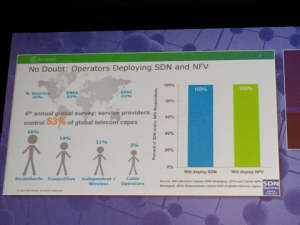
Running from 10-14 October in the World Forum in The Hague, Netherlands, Layer 123’s SDN World Congress brought together more than 1,600 industry experts. The event’s main message was simple: more industry players than ever are looking into NFV and SDN, and they are part of a tremendous journey that will change the industry fundamentally and forever.
It Always Comes Back to The Customer
Customer needs are changing rapidly, with a strong preference toward digital-first experiences. You can thank the influence of over-the-top (OTT) cloud service providers for that. Unsurprisingly, a lot of talk at the event was about delivering a superior customer experience through a more agile and elastic network environment. SDN and NFV are not goals to be achieved, but rather the means to service transformation to better the personal customer experience.
But, SDN and NFV are about more than technology evolution; they represent a paradigm shift that will change how future operators and businesses will work. Technology is a big part but people, processes and organisation are even bigger. The business case-led way of thinking and working is growing stale, as it’s unrealistic to build a “business case per network function” as we’ve learned in dusty old presentations about network management.
The Multivendor-Proof Network Eliminates Vendor Lock-In
We heard a lot about the idea of vendor interoperability, or what is described as building a multivendor-proof network. This characteristic is a must-have, since avoiding vendor lock-in is one of the biggest benefits of NFV and SDN technologies. These benefits exceed the traditional single-vendor network approach in every sense.
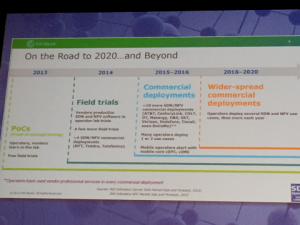 Of course, it won’t be easy to create a multivendor-proof network. It will require technology standardisation, cooperation, open source principles and set of defined interfaces: APIs. But it’s clearly the way the industry is headed, and the only way we will achieve the full benefits of virtualisation technology.
Of course, it won’t be easy to create a multivendor-proof network. It will require technology standardisation, cooperation, open source principles and set of defined interfaces: APIs. But it’s clearly the way the industry is headed, and the only way we will achieve the full benefits of virtualisation technology.
Standardisation Enables Multi-Party Cooperation
There was plenty of talk about the key role standardisation will play. Organisations like MEF Forum, Open Source MANO (OSM), the European Telecommunications Standards Institute (ETSI), OPEN-Orchestrator (OPEN-O) and the Open Networking Foundation (ONF) are leading the way. Comptel is involved in several of these groups, each of which focuses on its individual areas of expertise while encouraging collaboration, information sharing, discussion and debate. Ultimately, standardisation is advancing the multi-vendor and open-for-all approach to network design in acknowledgement of the desire for interoperability.
The nature of cooperative work within our industry is changing given this emphasis on multivendor networks. NFV and SDN are bringing companies together, leading to the creation of industry blueprints, proof of concept trials, and field experiments. Comptel is already involved in several, in fact.
The Network Automation Cycle
Many industry players at the event underlined the importance of automation and orchestration, driven by real-time analytics that rely on data and closed-loop processes to improve customer experience. They also advocated end-to-end seamless orchestration across new virtual and established services.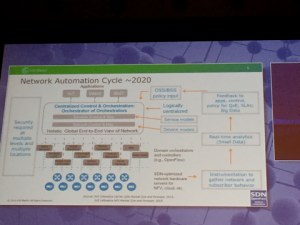
“Operations are the elephant in the room,” as one analyst aptly described significant operational concerns. Centralised and coordinated control and orchestration are the key assets that allow digital service lifecycle management in a hybrid network environment. The “orchestrator of the orchestrators” will be the enabler by providing a holistic, end-to-end view the dynamic digital services in multidomain networks.
There’s No Doubt: NFV/SDN Will Happen
NFV is going to happen; there’s no lack of confidence in the actual value of the technology. Of course it’s worth keeping in mind that it’s still early days for NFV, which remains an immature technology before standards become clear and stabilised.
The switch to virtualisation is both a technology and business challenge but even more it’s about culture, people, processes and trust. The true value of virtualisation comes back to the customer: you and me. At the end of the day, successful transformation will be about education, experimentation and strong relationships.
Network virtualisation will be a hot topic at Nexterday North 2016, which runs from 28-29 November in Helsinki. Register now to reserve your spot at the show.
]]>
The Nexterday Tour 2016 is our global effort to share the latest, most dominant and most appealing market trends directly with our customers and partners. At the same time, we discuss key thought leadership themes, including how Comptel’s software addresses market requirements in Nexterday.
We want to tap into the latest industry trends and insights from major global industry events, including our own Nexterday North event, which asks telcos to stop thinking about digital transformation and start executing. We package everything together with content and videos from operators, industry speakers and thought leaders, and go on tour to deliver them to telcos around the world.
What is the Nexterday Tour?
The program includes trends and insights gathered from a number of big events, stretching from the Comptel anti-seminar Nexterday North in Helsinki last November, and extending through Mobile World Congress in Barcelona, TM Forum Live! in Nice, the Big Communications Event in Austin, and a scattering of NFV/SDN events throughout Europe and the U.S. Our next stop will be in October for Dreamforce in San Francisco and the SDN and OpenFlow World Congress in The Hague.
It’s the third consecutive year we’ve run a global program. You might have known our previous tours by other names – “Barcelona in a Box” in 2014 and “Beyond the Event Horizon” last year. We visited more than 15 cities last year, meeting with 400 individual customers from 45 global operators.
So far, this year’s tour has taken us to South America, Europe and the Asia Pacific region, adding up to over 10 countries, over 15 cities, dozens of operator brands and hundreds of individual customers. And the tour finishes with our second annual Nexterday North from 28-29 November, 2016 in Helsinki.
Top Themes for 2016
Our focus in 2016 is on digital transformation and disruption within the telco industry.
We wanted to cover how new players in telco – including startups, but also non-telco players like Airbnb, Uber and Spotify – are shaking up the industry with innovative digital offerings that require operators to change their approach.
We’re also covering broader global trends. In his keynote speech at Nexterday North 2015, Kjell Nordstrom talked about urbanisation, describing how within the next 20 to 30 years, 80 percent of the world’s population and 90 percent of its economic value will be centralised in 600 megacities. On the tour, we’ve discussed what that means for telcos in the years ahead.
Similarly, we’ve heard frequently about the increasing value placed on customer experiences. A massive 89 percent of companies planned to compete on the basis of customer experience this year, according to Gartner. How has digitalisation influenced that trend, and – as keynote speaker Mike Walsh will discuss at Nexterday North 2016 – how does the increasing level of consumer familiarity with digital tools and services impact telco innovation?
We’ve discussed new telco business models, new network technologies and new service opportunities. We know that networks are embracing software in the era of NFV, data centres and cloud. We know that the Internet of Things (IoT) is a major opportunity, but that 99 percent of devices aren’t connected to the internet yet. At the same time, we know that up to four billion people on Earth also lack internet access. So what are operators and the whole industry doing to solve that challenge, alongside the others?
We’re also covering a number of challenges and opportunities in our industry, such as the need to find fresh new data monetisation strategies to take advantage of customers’ hunger for digital services. We also discuss the increased need for hyper personalisation in marketing, sales and service, and the need for telcos to re-engineer their service orchestration models to suit a more self-serve, conversational and automated service delivery lifecycle.
It’s been exciting to get out of the office, speak directly with customers and hear their ideas and thoughts on all of these concepts. Generally speaking, we’re seeing operators starting to broaden their mode of thinking. Ideas that would have once been considered too radical for telco are now being carefully considered, whether it’s ways to change how we work, new service opportunities to tap into, or new global trends that affect our business.
It’s important for telcos to continue the conversation and step away from the industry’s collective blindspot. With the Nexterday Tour 2016, Comptel is proud to play a part in helping operators have these important discussions.
Join us on the Nexterday Tour 2016 by registering for Nexterday North 2016, 28-29 November, in Helsinki. You can check out our fantastic speaker lineup here, which to date includes digital transformation visionary Mike Walsh, marketing guru David Meerman Scott, futurologist Dietmar Dahmen, operator speakers and many more.
]]>
Comptel explored the fibre broadband opportunity from every angle in a recent series of webinars. In the first session, “How to Build a Perfect Setup and Business Model for Fibre Connectivity and Services,” Comptel CTO Simon Osborne was joined by analyst Dean Ramsay of Analysys Mason and product manager James Wheatley to discuss the market opportunity and ideal business model for fibre services.
Ramsay explained that, per Analysys Mason estimates, about 50 billion in U.S. dollars was spent on worldwide capital expenditures related to fibre-to-the-x (FTTX) capabilities. That was about 2 percent higher than 2014, said Ramsay, who added that more than half the world’s consumers will have access to fibre internet by 2020.
That would be an ideal outcome for many consumers, who are starved for faster internet to support complex home networks. The average household will run multiple fixed and mobile devices from a single home Wi-Fi network, and with bandwidth-greedy services like 4K video ready to enter more homes, demand will only increase in the years ahead. Ramsay explained that most consumers now know that fibre is the latest and greatest technology for fixed broadband services, which makes fibre capability an attractive marketing tool for operators.
Of course, to offer fibre, operators need to solve a number of infrastructure, network and service challenges. In his part of the presentation, GE’s James Wheatley explained how proper network design – focused on automation, optimisation and a single view to disparate networks – can help operators efficiently meet overwhelming demand for higher bandwidth services. He also offered best practices for aligning physical inventory to meet customer expectations around service availability and quality. Watch the first webinar here to learn more.
In the second webinar, Ramsay and Comptel’s Patrick Wijngaarden elaborated on our project with Chorus, a New Zealand-based operator that completed an aggressive fibre deployment in less than one year. “How Chorus Cut 40% of Service Delivery Time with Modernised Fulfilment” provides a strong case study for intelligent service fulfilment around fibre, as Chorus was able to roll out fibre to a majority of the country’s population thanks to an automated fibre provisioning process devised by GE and Comptel.
This type of intelligent network transformation, which limits disruption to the network while significantly increasing operator capabilities and service opportunities, provides a crucial blueprint to operators exploring fibre deployments. The third and final webinar in our series provided another compelling example, this time from POST Luxembourg, which navigated the delicate balance of a corporate split-off by adopting a more dynamic, efficient and automated fulfilment architecture to serve existing and future demands from customers. Watch “Agile Delivery Leading to Successful OSS Transformation” to learn more about that story.
As we’re seeing from worldwide activity, fibre will undoubtedly continue to be one of the top services those customers demand in the years ahead. Not only will fibre deployments help operators keep up with consumer expectations, but as Comptel VP North America Peter Middleton explained recently, fibre capabilities could also be the difference-maker that helps smaller operators compete with larger players in key markets like United States.
The only thing standing in the way? Network transformation. Chorus and POST Luxembourg proved that the network does not have to be an obstacle to service opportunity, as long as you know how to devise an intelligent and efficient strategy for evolution.
Watch the complete “Winning with Fibre” webinar series to catch up on the issues around fibre connectivity and to receive a blueprint for building the perfect business model for fibre connectivity and services.
Watch part 1: “How to Build a Perfect Setup and Business Model for Fibre Connectivity and Services”
Watch part 2: “How Chorus Cut 40% Of Service Delivery Time with Modernized Fulfilment”
Watch part 3: “Case Example – Agile Delivery Leading to Successful OSS Transformation”
]]>
Comptel was in attendance for the second annual NFV World Congress, held last month in Silicon Valley. Whereas the discussions at last year’s inaugural event were more academic in nature, this year’s conference showcased a number of compelling cases that demonstrate how network functions virtualisation (NFV) is taking a step toward becoming reality.
The week kicked off with a series of tutorials from the Open Networking Foundation (ONF), the European Telecommunication Standard Institute’s (ETSI) Industry Specification Group (ISG) for NFV, and the Intel Network Builders (INB) – Comptel is a proud member of the latter two groups. Throughout the week, we also observed a number of presentations from operators driving home the reasons why they are exploring NFV implementations. Two reasons stood out:
- The potential reductions in CAPEX/OPEX due to utilising ubiquitous general purpose hardware
- The ability to achieve service flexibility and mix and match services.
NFV in Action
Japanese operator NTT offered a great example of the benefits of service flexibility. During a tsunami in 2014, the need for voice traffic capacity near the storm’s epicentre increased dramatically. There was plenty of capacity in the other parts of their network, so if NFV had been available at that time, NTT would have been able to offload data capacity to other parts of the network to increase voice capacity in areas that would have needed it most.
NTT was the only operator at NFV World Congress running two different virtualised evolved package core (vEPC) vendors on live deployments: NEC and Fujitsu.
AT&T, Verizon and the bulk of the operators speaking at the event said that virtual customer premises equipment (vCPE) for enterprise-based services is the most compelling of the NFV use cases for them. When pressed, AT&T described how their customers had surprised them in the way they utilise services.
By using the AT&T ECOMP platform and EVPN as the bridging mechanisms for Layer 2 and Layer 3 switching, plus allowing their customers to chain virtual network functions together, customers enjoyed time-of-day-based services variation. For example, during the workday all branch offices had equal bandwidth to access the main datacentres, whereas after business hours those bandwidth allocations were lowered and higher bandwidth was assigned for datacentres to sync together.
Other operators said they are entrenched in NFV trials, but didn’t offer any behind-the-scenes information as to how those programs are progressing.
The Emergence of Open Source
Another important theme was the increasing mainstream relevance of open source projects, which major network equipment providers (NEPs) and communication services providers (CSPs) are relying on to prevent vendor lock-in within the network.
It seems 2016 is the year of orchestration wars, with two different open source projects exploring this aspect of network management and organization (MANO): Open Source MANO (OSM) and OPEN-Orchestrator (OPEN-O). It’s difficult to directly compare the two initiatives, since OSM is based on available software, whereas OPEN-O is only in its foundational stages.
Nonetheless, it will be interesting to keep an eye on each initiative as they progress. Comptel recently participated in a partner showcase at TM Forum Live! alongside Telefonica, Indra and Etiya which proposed a hybrid network environment based on OSM.
NFV World Congress offered a compelling venue to explore how leading operators and vendors are actively experimenting with NFV implementation. As a few pioneering telcos embrace virtualisation within the network, these first forays will carve a clear path forward for the rest of the industry. Some will take the lead; others will simply follow.
Comptel’s proposed Digital Service Lifecycle Management (DSLM) model is just one example of how we are creating new possibilities for service orchestration through NFV implementation. Download a new whitepaper from Heavy Reading to learn more about this concept, and dive into the conversation on Nexterday.org, our online magazine and reader community.
]]>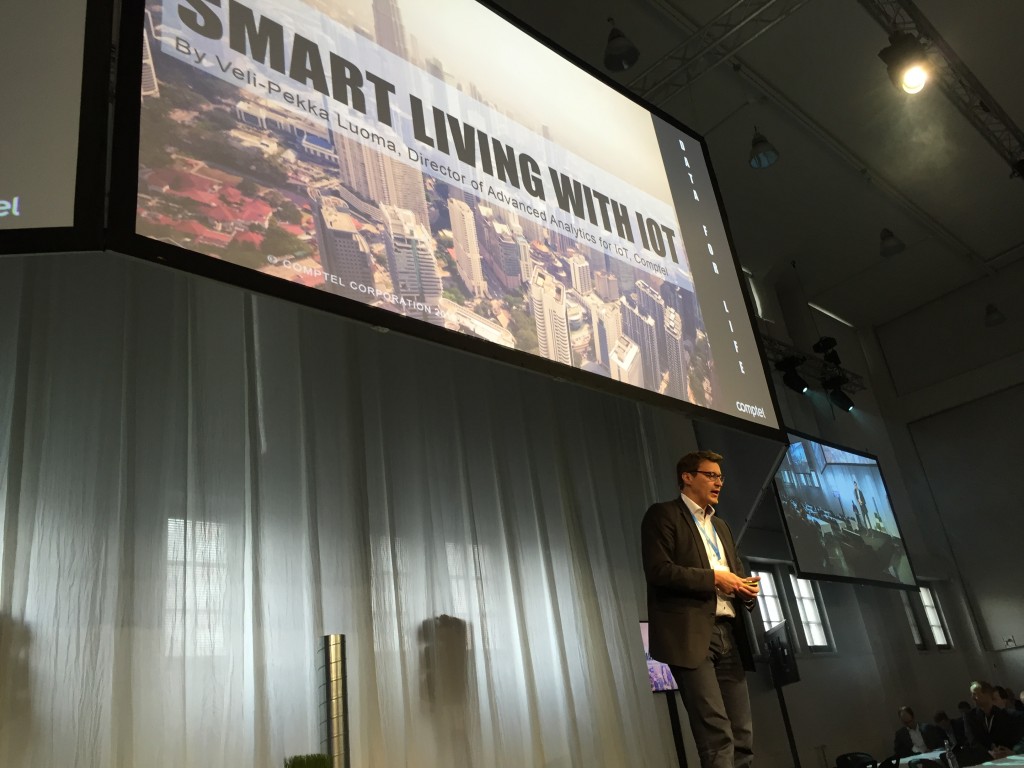
Veli-Pekka Luoma, Comptel
Although environmentalism was a major theme (event organisers used recycled wooden pallets as booth tables, for example), the event and the attendees were focused on different kind of environment: the holistic IoT ecosystem. There was one common denominator: Nearly everyone in attendance, across industries, was looking for technology partners to help them build or expand their own ecosystem of connected device solutions.
Comptel sponsored #IoTNordic and presented a speaking session with our Director of Advanced Analytics for IoT, Veli-Pekka Luoma, about the vital role data plays in the Smart Living movement. Comptel’s Intelligent Fast Data solutions offer businesses the power to sense, understand and act instantly on data “across the board.” Connected devices are another data source that produces aggregated information, alongside customer interactions, the network, social media, location and more. Businesses stand to benefit tremendously by pulling insights from all those different sources and applying insights to real-time actions. Those actions lead to better IoT-enabled experiences.
Industry can remotely monitor heavy machinery to run a “smart factory.” Health care providers can track personal data to offer intelligent preventative care, fleet managers can optimise routes for cargo vehicles, utility providers can provide efficient energy solutions with smart meters, and much more.
It all starts with smarter data. Through experimentation, partnership and solution co-creation, businesses – including operators – can apply data analytics to elevate the IoT beyond simple machine-to-machine communications toward humanistic benefits. #IoTNordic offered several compelling examples of businesses that are already succeeding in the IoT.
Elisa’s IoT Innovation Challenge
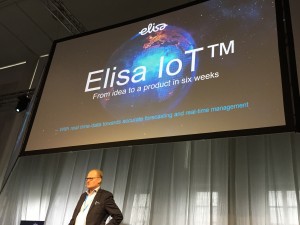
Elisa VP Markku Hollström
The Finnish operator Elisa has enjoyed many successes along its digital transformation. Its IoT service offering is one example. The company offers IoT connectivity, monitoring and analytics to a range of verticals, including a 3D real-time “Smart Factory” dashboard for industry, augmented reality solutions, and analytics-enriched monitoring and email notifications for the marine manufacturer Wärtsilä.
Elisa VP Markku Hollström explained that to succeed in the IoT, you need to experiment and develop a broad network of partners. That enables speed – the company profiled IoT projects that went from ideation to product in just six weeks. It’s also why the company is inviting businesses to participate in the Elisa Innovation Challenge, which will reward up to €85,000 in prizes to entrants who create innovative corporate and Smart Home IoT solutions.
Technology, Customer Experience the Focus for Tesla
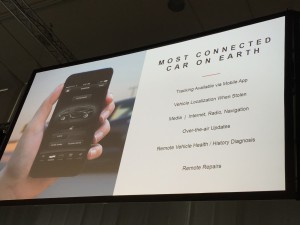
Tesla presentation at IoT Nordic
The electric car manufacturer Tesla says it is not in the business of selling luxury vehicles. At the show, the company’s speaker said the company’s focus is actually in transitioning the world toward safer, sustainable transportation. The IoT plays a big role in that: Tesla says its vehicles are the most connected cars on Earth, and their mission is to incorporate technology to create a software-based, analytics-informed driving experience. Even their car buying experience is innovative; it’s entirely online, making it a modern, customer-focused approach to purchasing.
Are Device Implants the Future of Health?
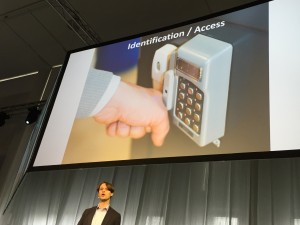
Hannes Sjöblad, BioNyfiken
Hannes Sjöblad of BioNyfiken presented a fascinating look at the role of NFC implants in human health, which his company says is humanity’s “personal key to the IoT”. This technology already exists – in fact, we saw a live demo at the end of his presentation of a human implant placed into a person’s hand. While also a bit scary, the demo did show the amazing potential of implanted devices to enable everyday individuals to “speak” to connected devices.
There are simple but very relevant use cases, like replacing keys, ID cards, tickets and boarding passes with implanted chips, and use cases that are more humanistic. Personalised chips could ensure a gun can’t be operated by an unauthorised user, for example, or even play a role in curing blindness, deafness and paralysis.
Securing the IoT
Of course, any conversation about the many uses cases for the IoT eventually falls back on security concerns. In his keynote speech, Mikko Hyppönen, Chief Research Officer of F-Secure explained that the IoT will only expand the number of threat vectors (how do you secure your Wi-Fi if it’s being shared by your refrigerator?), creating more opportunity for highly sophisticated cyber criminals and making it more difficult for consumers to maintain privacy.
The number and variety of IoT devices will make single-device protection impractical, said Hyppönen. F-Secure, for example, has no interest in developing anti-virus protection for your connected toaster. However, the company does develop full-home Wi-Fi security solutions to ensure every device on the network is secure. Furthermore, F-Secure compensates independent hackers who find holes in their security system, when many of those hackers may have otherwise sold that information to cyber criminals. It’s a good solution for F-Secure: Paying for hackers to find holes in your system is a clever and efficient way to find vulnerable spots in your environment.
As Hyppönen said, ”Web content is not free. It is paid for with your data. It’s paid for with your privacy. And it’s too late to change that. We have raised a whole new generation who are used to having content for ‘free’ on the web. And yet, we don’t understand what this means.”
That’s an important takeaway to keep in mind as businesses and operators tiptoe – or dive head-first – into the futuristic world of the IoT.
Learn more about the IoT opportunity for telco in a new whitepaper from Comptel and Heavy Reading. Download “Smart Cities & Smart Living: The Role of Telecom Operators.”
]]>
Comptel is taking part in three distinct partner-driven initiatives, including two TM Forum Catalysts, individually led by Telefonica and Orange; and an IBM-led digital service architecture blueprint. The ultimate objective of each initiative is to open operators’ eyes to new possibilities for infrastructure management, service delivery and offer creation through NFV service orchestration and intelligent fast data management.
Our contributions vary by project. In two of the cases, we’re putting the digital service lifecycle management (DSLM) model that we introduced in Nexterday: Volume II, with our FLOWONE service orchestration technology, managing forward-looking approaches to service delivery. In the third project, we’re supplying expertise and technology in the creation of a new, progressive data monetisation strategy.
Forward-thinking approaches are crucial at a time when customers desire fast, intelligent, personalised offers. Operators are also keen to take advantage of dynamic, intelligent, highly automated and virtualised network environments to speed up innovation, time-to-market and to improve security.
Here’s what you can expect from each partnership, with guidance on how you can learn more and engage with Comptel and our partners at TM Forum Live! 2016.
IBM’s Target Architecture for Cloud-Based Networking
Comptel, IBM and Juniper Networks have developed a new approach to digital service delivery for B2B and B2C customers, incorporating an orchestration and fulfillment architecture that allows operators to better manage end-to-end service lifecycles in complex hybrid networks of virtualised and non-virtualised services.
The architecture is based on our DSLM proposition, which you can read more about in a recent blog from our CTO Simon Osborne. The end-game is a network that’s able to automatically and dynamically deploy network capabilities and agile services in a way that gives customers automated, self-service digital service purchasing and delivery.
To learn more, visit the IBM booth at TM Forum Live!
Open Source NFV Service Orchestration and Lifecycle Management Catalyst with Telefonica
Comptel is also participating in two TM Forum Catalysts, which are proof-of-concept initiatives that encourage technology partnerships in the name of industry innovation.
The first is the NFV Service Orchestration and Lifecycle Management based on Open Source MANO Catalyst – sponsored by Telefonica. Along with Indra and Etiya, the initiative centres on Open Source MANO (OSM), an ETSI project to develop an open source stack for NFV management and orchestration, demonstrated here within a hybrid network environment.
DSLM also plays a crucial role in this Catalyst, as does our FLOWONE V service orchestration solution. The aim is to test the OSM software stack in a practical context and analyse how it needs to evolve to be production-ready.
To learn more about this Catalyst, join Telefonica and Comptel for our theatre session on Tuesday, May 11, 14:30-14:50 at the Catalyst Theatre.
Orange’s Catalyst on a Mobile Sponsored Data Business Model
Finally, Comptel will take part in an Orange-championed Catalyst, “New Business Models with Mobile Sponsored Data,” which also includes partners Salesforce and CloudSense, plus Sigma Systems and DataMi. We’ve contributed our Intelligent Fast Data technology and capabilities to illustrate how enterprises can sponsor mobile customer data usage as a way to incentivise the use of enterprise digital services, increase data engagement, collect usage data and apply policy control.
To learn more about this Catalyst, attend our session titled “New Business Models with Mobile Sponsored Data” at the Catalyst Theatre on Wednesday, May 12, 13:40-14:00.
Comptel is proud to partner with each of these technology leaders in collaborative efforts to introduce new solutions to communications. Whether it’s by improving digital service delivery through new infrastructure models, further developing OSM, or enhancing customer engagement through the creation of new business models, we’re excited to pioneer digital transformation. We can’t wait to share our progress with attendees at TM Forum Live! 2016.
Visit TM Forum’s Catalyst Zone to see these Catalyst demonstrates in action. To arrange a meeting with Comptel at TM Forum Live! 2016, email [email protected]
Learn more about the orchestration capabilities of Comptel’s FLOWONE and download a copy of the Comptel and Heavy Reading research report, “Digital Service Lifecycle Management: How Communications Service Providers Can Play a Successful Role in the Digital Economy.”
You can also learn more about how Comptel is enables operators and global enterprises to act on Intelligent Fast Data in our recent Intelligent Data webinar.
]]>
Personalisation. Convenience. Instant gratification. Customers want it all, and technology means top brands are able to deliver. As a result, we’re operating in a new digital economy, one that’s driven by personal choice and an experience-led approach.
So why are many operators still struggling to deliver a convenient, automated and engaging customer experience?
The digital service purchasing process needs to evolve, and since we first discussed this topic in last year’s Operation Nexterday, we’ve heard some great success stories from operators who are undergoing that transformation. But we’ve also heard from operators who need guidance devising and launching a new model for digital service delivery.
That’s why, at next week’s TM Forum Live!, we are launching a proposed architecture for digital service delivery in partnership with IBM and Juniper Networks. The IBM platform for Cloud Based Networking (CBN), intends to maximize the agility offered by network function virtualisation (NFV) and software-defined networks (SDN) to create a better model for service delivery in the digital age.
What NFV/SDN Can Do for Digital Service Delivery
As I wrote in a recent LinkedIn Pulse piece, the virtualisation of networks and services empowers operators to present customers with the right services at the right time. That’s because NFV and SDN offer the infrastructure agility and flexibility to rapidly create new digital services, including their operational aspects, at maximum speed and minimum cost. In other words, NFV and SDN allow operators to move fast enough to create a more immediate and satisfying digital customer experience.
Of course, given that the embrace of NFV technologies won’t happen overnight, this vision doesn’t require a dramatic shift to a fully virtualised network. Instead, operators will deploy NFV capabilities as “islands” within their infrastructure, leveraging existing physical resources and associated OSS/BSS platforms as part of a hybrid approach for some time to come.
The Comptel/IBM/Juniper initiative, which is built in accordance with the Comptel Digital Service Lifecycle Management (DLSM) model proposed in Nexterday: Volume II, takes this hybrid approach into account. Designed as a three-tiered architecture, DSLM relies on a central orchestration layer that manages requests from the top customer engagement and business management layers, and supports those requests with appropriate resources from the bottom virtual and physical resource layer.
Each layer works together to deliver automated order validation, self-service customer configuration and intelligent resource management for easy scalability.
Creating Reality from New Digital Service Possibilities
How would this all be exposed to the customer? Through a better digital buying experience.
Customers should now be able to self-configure and order a broader range of services from a digital catalogue, and the operator’s infrastructure would handle the automated creation and immediate fulfillment of those services.
In the enterprise world, businesses looking to add on a new IT or communications service will be able to abandon the legacy linear purchase process that’s plagued by lengthy requirements reviews, proposals and bids which lead to delays, fallouts or generic IT implementations. Instead, much of the enterprise sales process will be automated, helping operators improve experience and sales.
The model creates a foundation for operators to easily grow and deliver a wide range of new service capabilities. With NFV, operators are able to assume the role of digital service aggregators, setting up marketplaces for B2C and B2B buyers to purchase existing and emerging digital services. For enterprise customers, that might even mean buying the very virtual functions they need to provision their own networks.
Ultimately our partnership with IBM and Juniper aims to reveal the business potential of virtualised networks when applied to service delivery – and how it unlocks new possibilities for operator service growth.
We invite you to visit the IBM booth at TM Forum Live! in Nice, France, from 9-12 May to learn more about the IBM Cloud Based Networking initiative and our model for dynamic digital service delivery. Email [email protected] to schedule a meeting.
You can also read more about the initiative from Comptel CTO Simon Osborne, read the Heavy Reading white paper or catch up on our view of digital service lifecycle management on Nexterday.org, our online magazine and reader community.
]]>In the world of telco, emerging back office technologies – especially network functions virtualisation (NFV) – appeal to operators not just because of the promised evolution of infrastructure management, but also because of the potential difference these technologies can make to the bottom line.
It all starts and ends with digital services. We’re living in an app-driven world, where consumers build personalised ecosystems of apps and over-the-top (OTT) content. These customers are on the search for apps and services that solve specific problems or meet their unique needs, from personal health to entertainment and everything in between.
Businesses are the same way. Not only do companies want access to a wider range of digital capabilities – video and Web conferencing, cloud-based email and productivity software, connectivity and security services – but they also now expect a B2B buying experience comparable to the speed and personalisation they receive as B2C digital buyers.
How can operators deliver personalised, engaging service experiences to B2B and B2C customers? Through a conversational and automated service orchestration and fulfillment framework.
Comptel is partnering with IBM and Juniper Networks to develop just such an architecture. As a participant in IBM’s Cloud Based Networking (CBN) initiative, our aim is to leverage SDN and NFV technologies in the creation of an agile, self-service model for service configuration, validation and completion. We’ll share our new revision for OSS and dynamic digital service delivery with attendees and booth visitors at TM Forum Live! in Nice, France from 9-12 May.
Extending the Potential of NFV and SDN
Technologies in isolation don’t really change much about the state of play. The same is true for NFV. There’s nothing inherently disruptive about having a virtual version of a network function. Adding a “v” in front of OSS won’t mean you’ve revolutionised your business. It’s really about how you’ve applied that new technology to meet customer demands.
The real value of NFV is that gives operators the agility and flexibility to consider new ways to serve enterprise and individual customers. With a highly scalable, agile and flexible network, an operator can dream up and launch the innovative problem-solving services their customers want. In turn, the self-created apps and service ecosystem can drive new operator revenue streams.
The Model for Dynamic Self-Service Delivery
To bring this vision to reality, IBM is adopting Comptel’s Digital Service Lifecycle Management (DSLM) proposition. This NFV-driven model works across three layers: one for network orchestration, virtual function, IT and physical network management; a middle orchestration layer to manage end-to-end hybrid service orchestration and the digital service lifecycle; and a top layer for front-office customer engagement and business management.
Comptel’s FLOWONE V service orchestration solution will fulfil the central DSLM layer, while IBM and Juniper will provide the network domain and IT service orchestration, dynamic operations, customer engagement, DevOps and security applications and services. Through integration with a digital service catalogue, this three-tiered system is able to support fast and easy self-service product ordering and configuration at the customer level. The model accounts for automated validation to ensure service availability and feasibility, and includes intelligent resource management to ensure the system can scale for service demand.
In future blogs, we’ll dive into the market potential for this type of model and the technical aspects that make it possible. But for now, it’s clear to see the revenue possibilities for operators. With a smart, automated and self-service digital sales cycle, you empower customers to build their own personal ecosystem of digital services and apps. Agile NFV and SDN technologies let you deliver these capabilities at an attractive cost. Ultimately, this model presents an innovative way for operators to expand their service capabilities and unlock new revenue in the era of rising digital expectations.
Visit Comptel and IBM at TM Forum Live! to learn more about the IBM Cloud Based Networking initiative and our model for dynamic digital service delivery. Email [email protected] to schedule a meeting. You can also read more about digital service lifecycle management at Nexterday.org, our online magazine and reader community.
]]>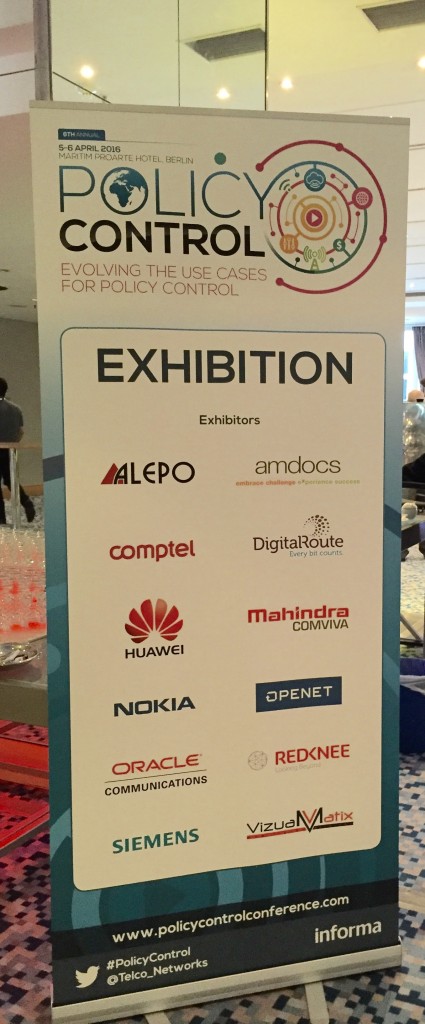 Policy control cannot be seen as a standalone function any longer. It needs to be combined with charging and predictive analytics to give customers the best, most contextual and personalised service experience. At the same time, effective policy and charging control also gives operators the flexible and agile tools they need to monetise data services. That was one big takeaway from the Policy Control Conference 2016, which bills itself as the world’s only event exclusively dedicated to the policy control market.
Policy control cannot be seen as a standalone function any longer. It needs to be combined with charging and predictive analytics to give customers the best, most contextual and personalised service experience. At the same time, effective policy and charging control also gives operators the flexible and agile tools they need to monetise data services. That was one big takeaway from the Policy Control Conference 2016, which bills itself as the world’s only event exclusively dedicated to the policy control market.
Nearly 200 policy control enthusiasts from 80 organisations gathered at Berlin’s Maritim proArte hotel from 5-6 April to learn about the latest and greatest developments in the field of policy control. The entire policy control ecosystem was represented, with scheduled presentations from solution vendors, operators and industry analysts. Executive speed networking, operator-hosted lunches, analyst breakfast roundtable briefings and operator and vendor dinner also offered plenty of opportunity for interaction.
Comptel was in attendance as a sponsor, and we also hosted “The Seven Deadly Sins of Policy Control,” a session with our VP MONETIZER Simo Isomäki and our VP Solution Architecture Martin Vieth. We highlighted the defective, broken aspects of policy control that needed to be corrected as operators evolve toward a modernised and future-proof policy environment. At the event, attendees heard how operators are addressing challenges like time to market, increasing customer experience demands and the introduction of virtualised functions into the network through innovation policy control management. Here are several big takeaways from the event.
Complexity Slows the Speed of Innovation
Network agility is crucial to delivering the flexibility operators need to achieve a higher speed of service creation, which is a valuable asset at a time when monetisation opportunities crop up at a moment’s notice. However, overly complex telco networks slow everything down, making it difficult or in some cases impossible for operators to configure and launch new services fast enough to attract customers at their peak moment of interest.
Simo and Martin explained that the blame lies with complex and scattered network architecture and management, which kills innovation. As a result, many operators are “dead slow” – 69 per cent of CSPs say launching a new product or changing a product takes too long, according to Heavy Reading. The right environment and toolset could speed things up by giving operators a single view to create and change products and allow for service creation experimentation. Operators should strive to innovate when it comes to service pricing, add-on apps, data bundle configuration, delivery speed and more to appeal to digitally savvy customers.
 NFV and Policy Control
NFV and Policy Control
Network functions virtualisation (NFV) is, naturally, one key area of innovation affecting policy control. PCRF is often one of the first network functions to be virtualised as operators seek to respond quickly to changing market conditions.
Many telcos in attendance acknowledged the benefits of NFV, including its ability to drive a 95 per cent improvement in service cycles, outweighed the potential challenges of implementation. Presenters argued that policy control and analytics should be tightly integrated with network and service orchestration, delivering service and customer awareness to the NFV and SDN network.
At the same time, the Comptel presentation emphasised simplicity above all in NFV implementations. Operators are striving towards NFV – one said “If you don’t do NFV, you’ll be left behind”. In our session, Simo and Martin advised a hybrid approach in which brand-new NFV infrastructure and legacy environments work in cooperation to maintain simplicity.
Analytics Enables Better Service Experience
Another major theme at the show involved the central role customer experience should play in policy and charging control management decisions. For example, moving away from the idea of standalone policy control and toward a vision for natively combined policy control, charging, predictive analytics and real-time business reporting helps operators deliver a better and more targeted end-to-end service experience.
One operator described how they currently analyse customer usage behaviour and patterns with a Big Data cognitive learning analytics platform. Using that data, they can guide their policy engine for example to offer the best service with the most attractive apps to customers. Predictive analytics also informs service testing, so that operators can test and affirm a new services’ success before launching it publicly.
 The Customer is at the Centre of Service Experience
The Customer is at the Centre of Service Experience
Forward-looking service creation puts the customer at the centre by selling services the way buyers want. As Fredrik Jungermann explained at Nexterday North 2015, customers buy data by the bundle today only because that’s the way operators choose to sell data, but that doesn’t mean it’s the only way or the perfect way to sell data. Rather than simply selling data on a small, medium, large or extra-large model, Simo and Martin advocated a model where data is flexibly bundled with attractive over-the-top (OTT) content services to appeal to the customer’s preference.
Additionally, there were discussions around the importance of offering consistent mobile service experience no matter the customer’s location. Presenters argued that there is value in policies being access-neutral whether a customer is on fixed internet, mobile data or a Wi-Fi network.
Similarly, operators could change the way the allocate bandwidth per application to improve service experience. Twitter and Netflix, for example, don’t need the same bandwidth speeds to run successfully, but that is currently how those apps are supported by many internet service providers. Why not flexibly support apps with an appropriate level of bandwidth, reserving the best speeds for live streaming videos?
Ultimately, that’s how operators and the industry need to think about policy control moving forward. The customer should always be at the centre of any major innovation in the network or otherwise, so an evolution in policy and charging control should likewise focus on improving the customer experience. Since complexity is the enemy of innovation, operators will need to only consider transformation that can make things work more simply and quickly.
Learn more about the tools how to monetise more in less time: Download our whitepaper about the MONETIZER™ or register to our MONETIZER™ webinar or click to read about our MONETIZER™. To keep up on the latest news and discussion topics, please join our Magazine and Reader Community in nexterday.org.